The Weber Searwood proved that Weber could finally go head-to-head with Traeger and Camp Chef in the pellet grill game.
So right out of the gate, here’s the big question: Can you buy the Smoque and pocket the difference, or will you always regret not getting the Searwood?
After a few weeks of cooking everything from ribs to brisket, we’ve got our answer. Watch our full hands-on video below, or keep reading for the complete review.
Weber Smoque Pellet Grill
Our Verdict: The Weber Smoque is an affordable entry into Weber’s pellet grill lineup that still delivers impressive low and slow performance. It holds steady temps and produces solid smoke flavor. While it can’t match the Searwood’s high-heat searing it’s a dependable, easy-to-use smoker for brisket, ribs, and everyday BBQ.
Pros:
- Excellent temperature consistency
- Simple Weber Connect setup
Cons:
- Limited searing performance
- Flimsy plastic wheels
CHECK WEBER PRICE
Weber Smoque VS Searwood: Which Grill Should You Buy?
Normally, I’d save the head-to-head talk for the end of a review, but with these two, it’s worth getting it out of the way early.
I have to confess, I was a little shocked when Weber announced this new pit. They had just nailed the release of the Searwood, a grill that finally made Weber a serious player in the pellet space and all but banished the memory of the SmokeFire from our minds. We even named the Searwood our best pellet smoker.
So when Weber revealed the Smoque, my first thought was, why mess with a good thing?
But once the pricing came out, it started to make sense. The Smoque sits a few hundred dollars below the Searwood, depending on size and region. Weber removed the direct-flame searing system and a few premium touches, but kept the same core cooking chamber, controller, and Weber Connect setup.
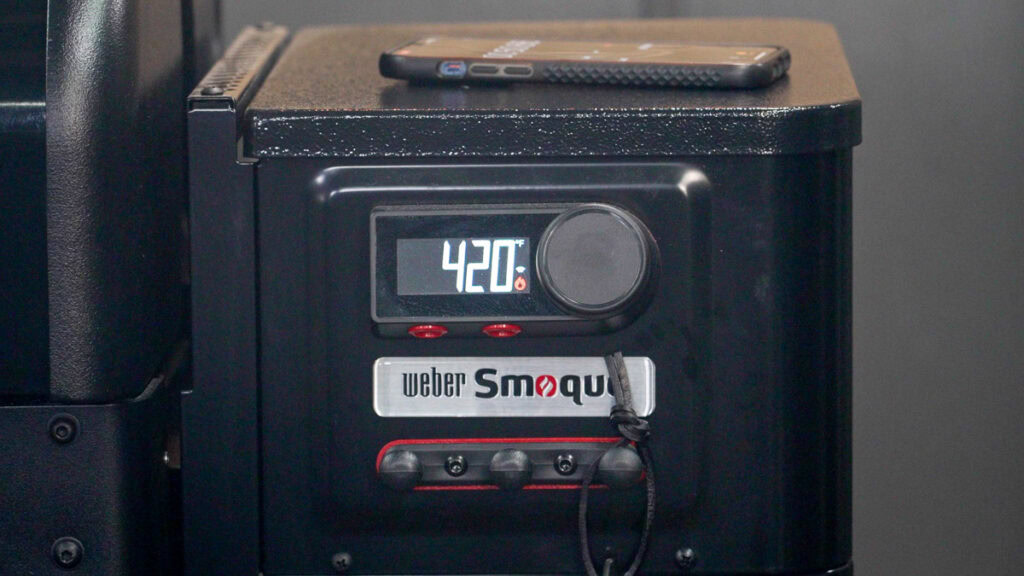
That means the Smoque still delivers the same even heat and steady temperatures that made the Searwood such a standout. What you lose is the high-heat searing and some of the nicer details.
In the end, it comes down to how you like to cook. If you spend most of your time smoking ribs, brisket, or pork butt, the Smoque gives you about 90% of the performance for less money. If you love grilling steaks or burgers at full blast, the Searwood’s extra power makes it a better all-rounder.
Unboxing & Assembling the Smoque
Weber’s packaging game is still top tier. Everything in the Smoque box comes snug, well-protected, and clearly labeled. Nothing rattling around, no mystery bolts hiding at the bottom of the carton. You can tell Weber’s been doing this a while.
Assembly is pretty straightforward, even if you’re not the handy type. It took just over an hour with a couple of helping hands, and most of that time was spent double-checking which bolt went where. Like I always say, leave your bolts a little loose until the whole thing’s together, then snug it up at the end. It makes life a lot easier.
We ran into the same minor quirk I saw with the Searwood: one stubborn bolt that didn’t want to catch its threads. It’s not a dealbreaker but worth keeping an eye on when you’re putting the cart together. Aside from that, the process was smooth and the parts all fit like they should.
Once it was standing, the Smoque felt solid. It’s lighter than the Searwood but still sturdy enough to roll around without flexing or wobbling. And yes, the kids immediately claimed “assembly supervisor” status, just like every other grill that shows up in my shop.
I reviewed the XL version, but besides the size the only other difference is the price.
What you need to know:
| Smoque (Standard) | Smoque XL |
|---|
| Total Cooking Area | 594 sq in | 918 sq in |
| Primary Cooking Area | 385 sq in | 595 sq in |
| Warming Rack Area | 209 sq in | 323 sq in |
| Closed Lid Dimensions (H × W × D) | 44.50″ H × 38.75″ W × 22.50″ D | 44.50″ H × 50.75″ W × 22.50″ D |
| Open Lid Height | 60.0″ H | 60.0″ H |
| Hopper Capacity | 22 lb | 22 lb |
| Weight | 102 lb | 110 lb |
| Max Temperature | 500°F | 500°F |
Do you still get that Weber build quality?
At first glance, the Weber Smoque looks a lot like the Searwood. It has the same shape, similar digital controller, and matte-black enamel finish that wipes down easily after a cook. Look closer and you can see where Weber made small adjustments to keep the price down.
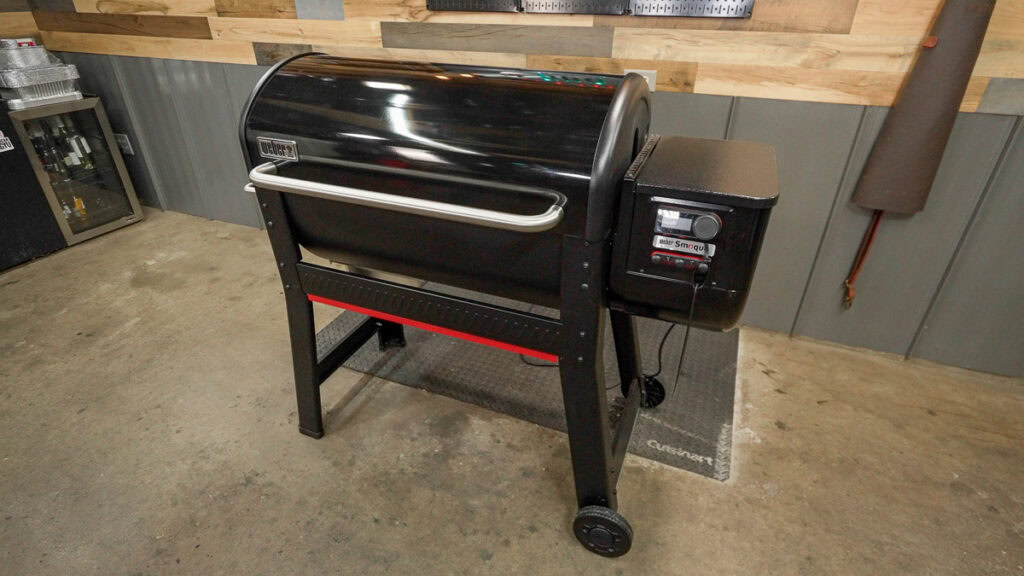
The cart and frame feel sturdy, though the lighter steel makes it a bit easier to roll around than the Searwood. The trade-off is that it feels slightly less solid when you move it. The wagon-style wheels roll fine across patios, but the plastic design feels like the one area that could use an upgrade.
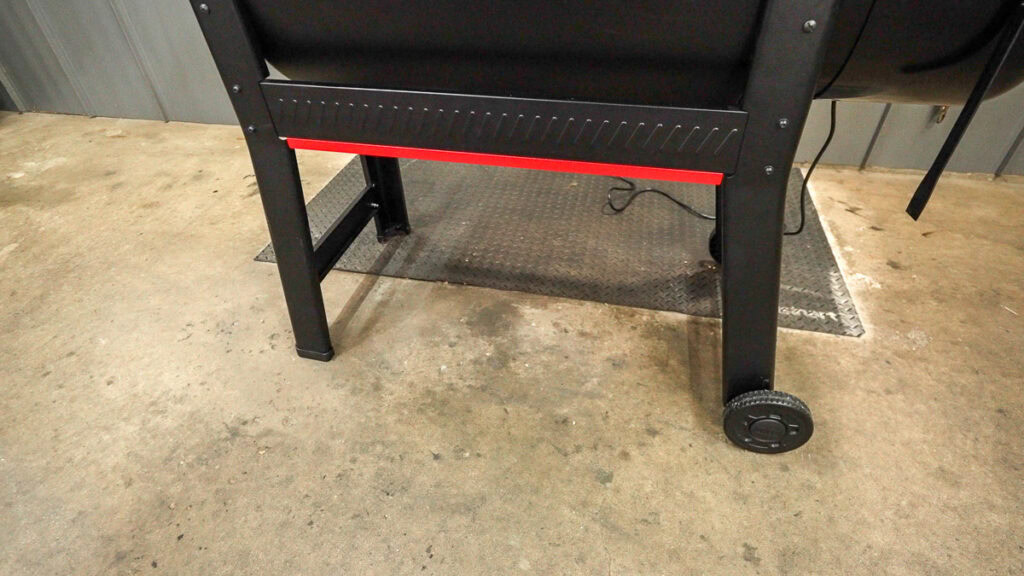
Up top, the cooking chamber shows classic Weber quality with thick steel and a smooth enamel coating that resists grease and smoke buildup. The lid opens easily, and the gasket seal holds heat well for a mid-range pellet grill.
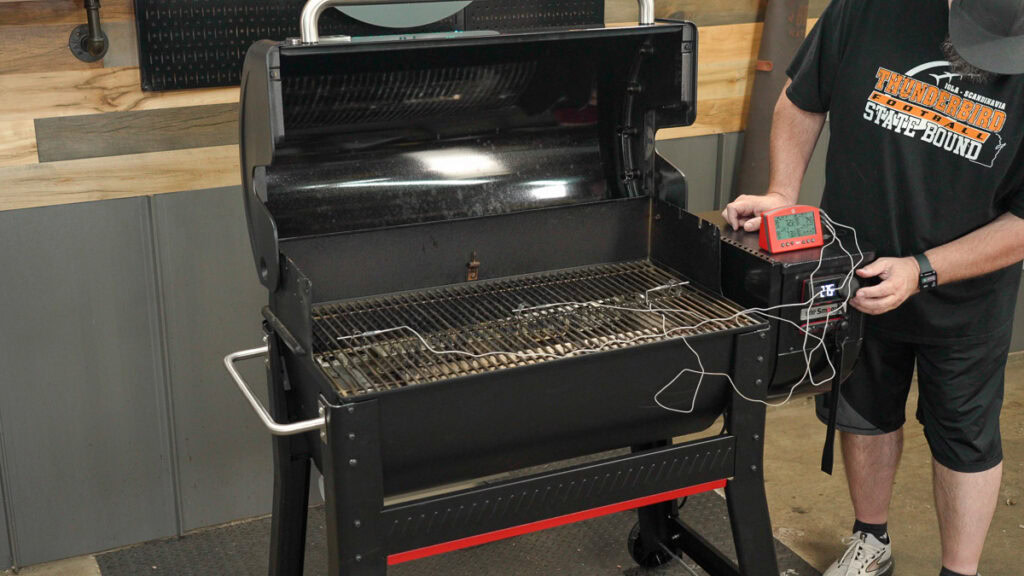
Inside, Weber kept the same vented heat management system as the Searwood, which helps spread heat evenly from the right-side firepot across the grate. It’s a simple design that works well.
One plus of no smoke stack, putting the cover on and off is a breeze. I’m always getting my covers stuck on those darn things.
There isn’t much prep space out of the box, so the optional side or front shelves are worth adding if you like to keep trays close by. Three tool hooks sit on the side, and the ash and grease trays are tucked neatly below the chamber to keep things tidy.
Overall, the Smoque feels like a well-built Weber at a more approachable price. It may not have every premium detail, but the fit, finish, and performance all feel solid for the money.
Smoking Performance
In case the name doesn’t give it away, the Smoque feels most at home running low and slow.
During testing, it came up to 275°F in around 10 minutes and held that target rock steady. After a short preheat period, temperatures across the grates were nearly identical from left to right, which says a lot about Weber’s venting system and overall design.
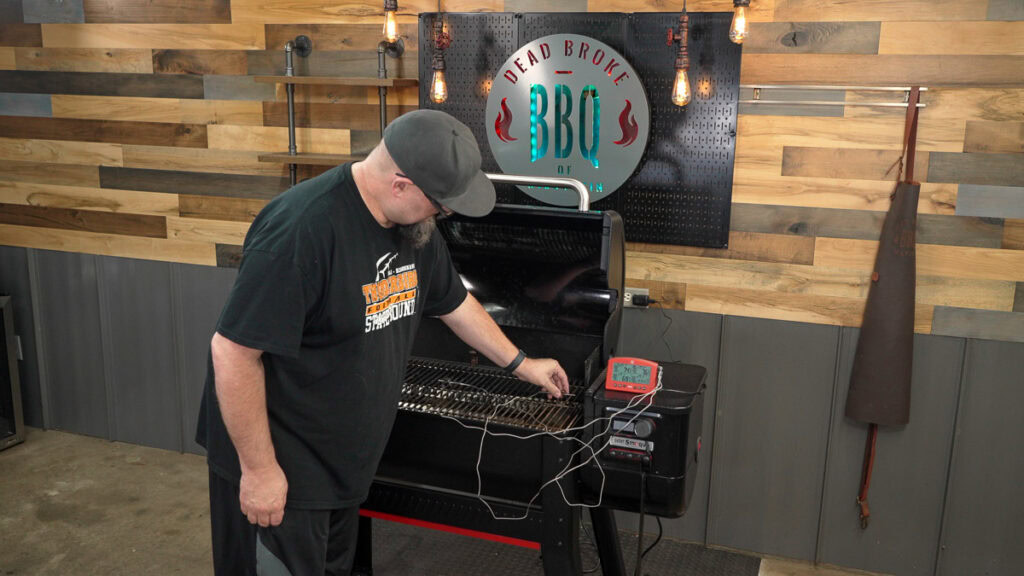
For an overnight brisket, it ran at 210°F without missing a beat. The hopper capacity was more than enough to carry through the night, and the fire stayed consistent the whole time. The brisket came out with a juicy interior, a clean smoke ring, and a balanced flavor that wasn’t overly heavy or bitter.
Spare ribs and beef back ribs also turned out well, with good color and even bark formation.
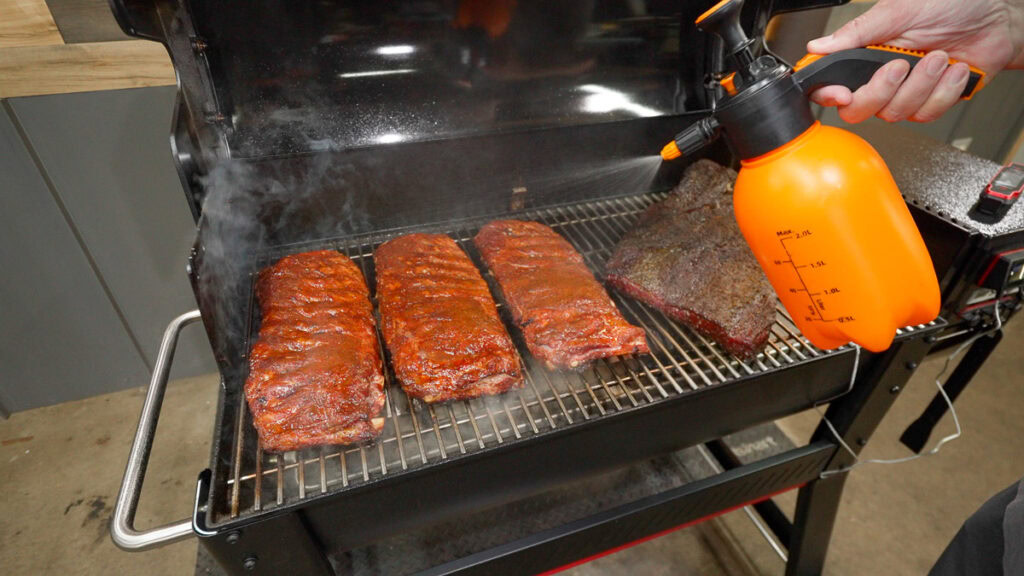
The Smoque produces what I’d call a moderate level of smoke. Enough to add noticeable flavor without overpowering the meat. It’s a setup that suits most backyard cooks who want reliable barbecue results without babysitting the pit all day.
Grilling & High-Heat Performance
Grilling is where you start to see the difference between the Smoque and the Searwood. The Smoque can reach 500°F, which is enough for burgers, chicken, or vegetables, but it doesn’t have the direct-flame capability that gives the Searwood its strong searing power.
In testing, steaks cooked evenly, but the grill marks were light and the crust was mild. You can get creative by using a cast-iron pan or finishing over a separate high-heat gas or charcoal grill if you really want that steakhouse-style sear.
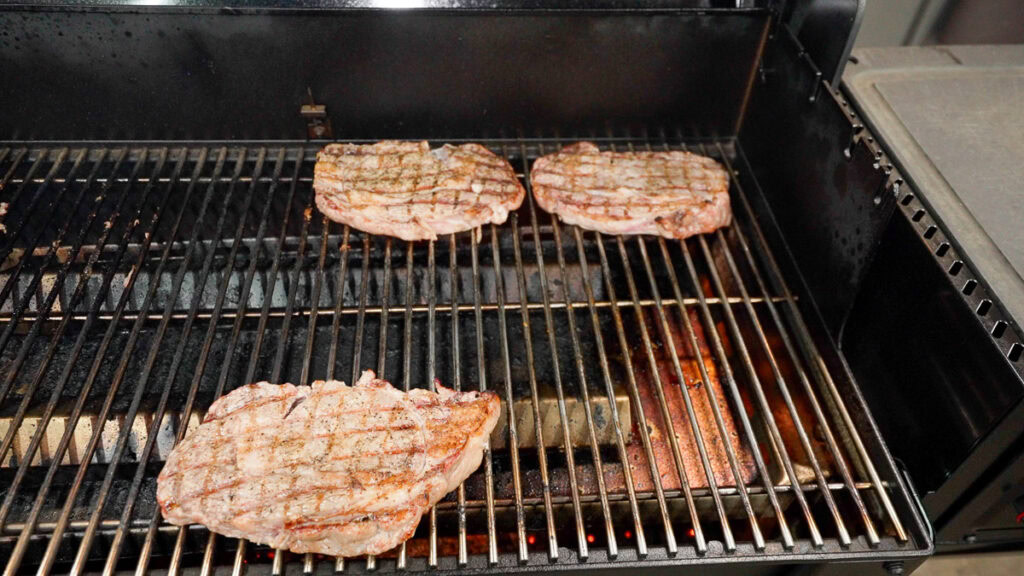
That said, for general grilling duties, it performs fine. It holds temperature well, recovers quickly after opening the lid, and doesn’t flare up or smoke excessively. If most of your cooking leans toward barbecue, the Smoque gives you everything you need. If searing is a priority, the Searwood still earns its price difference.
Cleanup & Maintenance
Cleanup on the Smoque is simple but not completely hands-off. The grill includes Weber’s combined ash and grease management system, which routes drippings into a disposable pan tucked neatly under the chamber. It keeps things tidy and out of reach for kids or pets, but you’ll still want to empty it every few cooks.
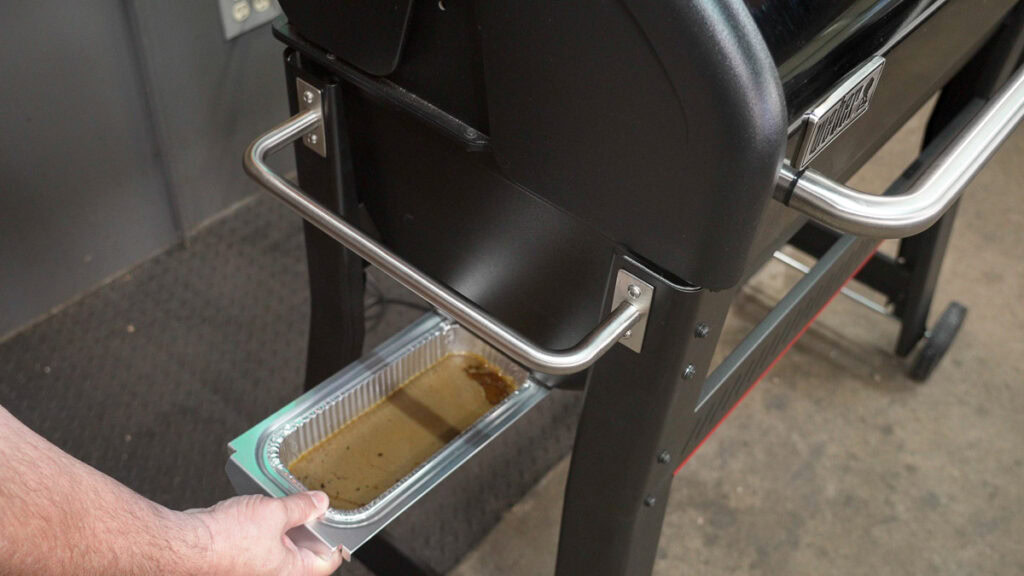
Most of the ash collects around the firepot rather than in the tray, so a quick vacuum inside the cooking chamber after three or four sessions keeps airflow clear and temperatures consistent.
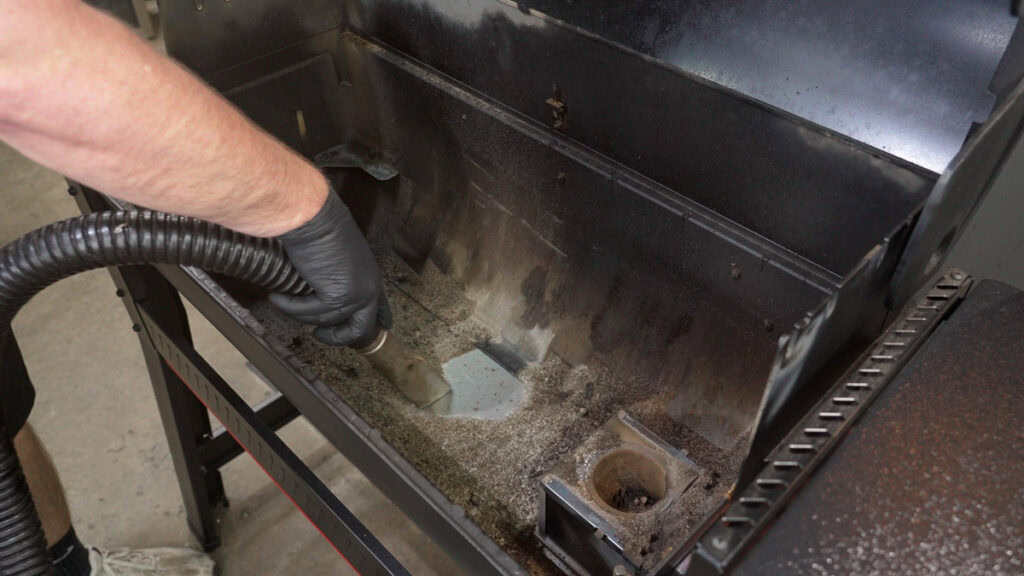
The enamel-coated interior and lid make wiping down grease and smoke buildup easy, and the grates clean up nicely with a light brush while still warm.
Maintenance is straightforward and much less messy than older Weber pellet designs.
Weber Connect & App Experience
Setting up Weber Connect on the Smoque is quick and painless. Just scan the QR code inside the manual, download the app, and it connects automatically with no need to fiddle with Wi-Fi settings or controller menus.
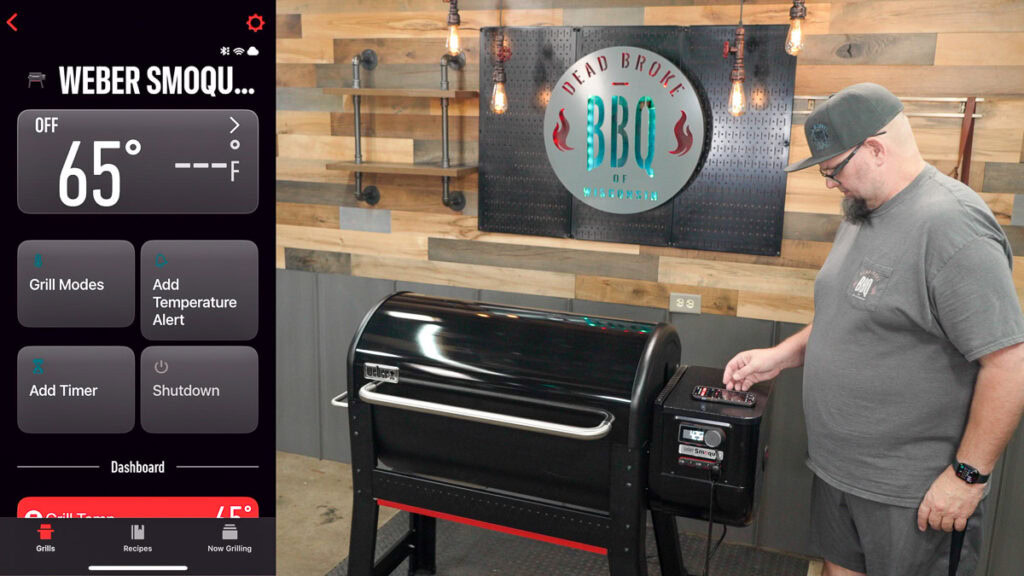
The updated app is cleaner and easier to use than the version that launched with the old SmokeFire. The layout is simple, temperature graphs are easy to read, and it gives you an instant snapshot of both pit and probe temps without hovering over the grill.
During testing, the connection stayed stable, and updates came through reliably.
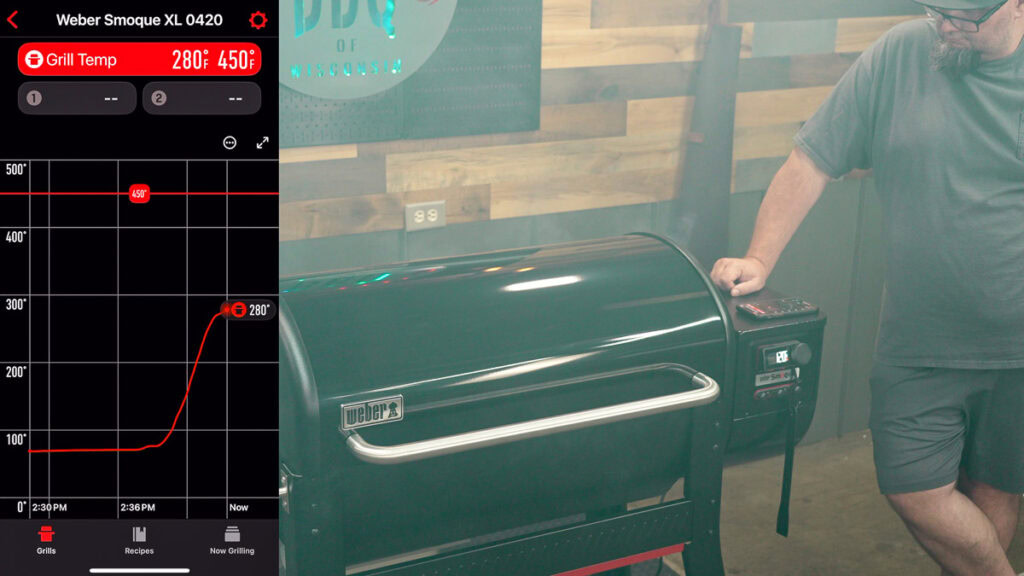
The Smoque includes a basic Smoke Boost setting, but you’re forced to stick to 180°F rather than a proper adaptive smoke mode like you find on the Camp Chef Woodwind Pro. It works fine for extra smoke flavor though.
You also don’t get he smart recipe automation or predictive cooking features found on some premium brands. Still, for tracking and monitoring your cooks, Weber Connect feels polished and genuinely useful.
How does the Smoque compare to the competition?
We’ve already covered how the Smoque compares with the Searwood, but what is the competition from other pellet grill brands?
The most obvious comparison is the Traeger Woodridge, Traeger’s new entry-level option.
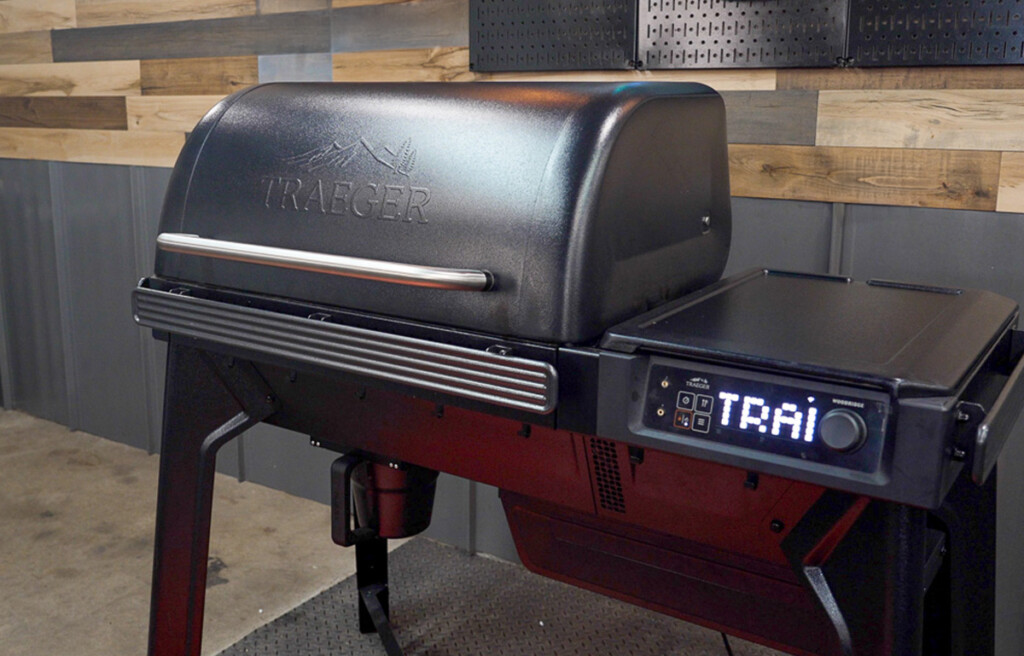
For a little bit more cash, the base Woodridge offers a larger cooking area and Traeger’s well-developed WiFIRE app, but its smoke output is light, and it struggles to sear. In our testing, food came out evenly cooked but lacked the deeper smoke flavor that most backyard pitmasters expect.
The Smoque, on the other hand, runs hotter, recovers temperature faster, and produces a more noticeable smoke profile. Its chamber design gives it more consistent heat from edge to edge, and Weber’s enamel finish makes it easier to maintain over time.
Traeger still wins on app polish and size, but the Weber edges it out on build quality, temperature consistency, and everyday usability.
Final Verdict
As barbecue enthusiasts, we’re always going to lean toward the Weber Searwood. The price jump isn’t huge, and the extra features, especially for high-heat searing, make it a more versatile all-rounder for anyone who likes to smoke and grill. It’s the model that finally erased Weber’s SmokeFire misstep and showed they could make a pellet grill that rivals Traeger at every level.
That said, the Smoque hits a really smart balance. If you already have a gas or charcoal grill that handles your high-heat cooking and want something reliable for low and slow barbecue, this is the one to get. It runs steady, produces great smoke, and is built well enough to handle years of use without fuss.
Did you miss our previous article...
https://manstuffnews.com/backyard-grilling/twice-smoked-spiral-ham
 Backyard GrillingWeekend WarriorsAdvice from DadBeard GroomingTV Shows for Guys4x4 Off-Road CarsMens FashionSports NewsAncient Archeology World NewsPrivacy PolicyTerms And Conditions
Backyard GrillingWeekend WarriorsAdvice from DadBeard GroomingTV Shows for Guys4x4 Off-Road CarsMens FashionSports NewsAncient Archeology World NewsPrivacy PolicyTerms And Conditions
